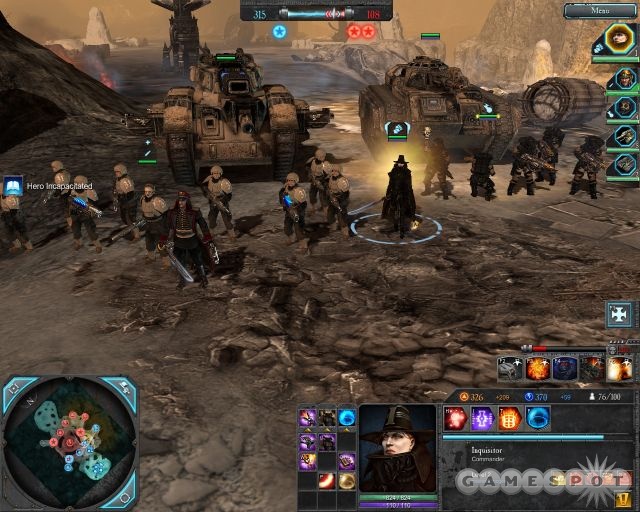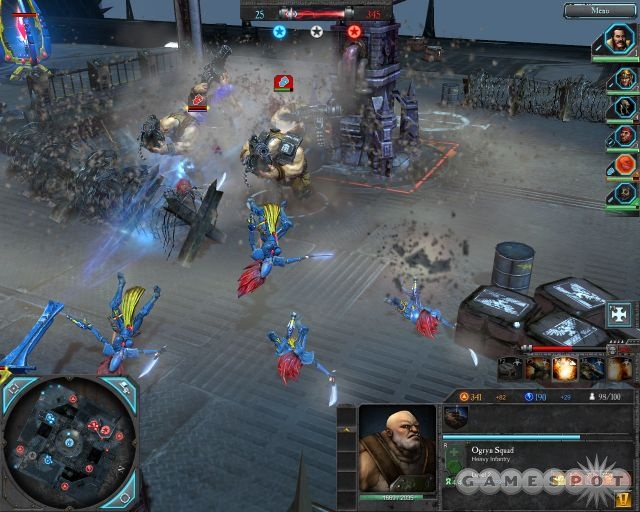Warhammer 40,000: Dawn of War II: Retribution Hands-On - The Imperial Guard and Multiplayer
The Imperial Guard are reporting for duty in the latest expansion for Dawn of War II, and we go hands-on to test their merit.
Released in 2009, Relic Entertainment's Dawn of War II skillfully shifted the focus of the series from grandiose battlefields to smaller, squad-focused gameplay. In 2010, the game's first expansion, Chaos Rising, introduced the forces of Chaos as a new playable faction, as well as expanded the single-player campaign. Now the third expansion in the series, Retribution, brings a wealth of new content for fans to enjoy. New maps, new units, and a revamped campaign that shares the spotlight across all factions are in the works, but what we're most excited about is the inclusion of the Imperial Guard. After some grueling hands-on multiplayer matches, we're ready to report on our tour of duty with these new cadets.
STAR WARS: Prequel Pack - Official Reveal Trailer DEAD OR ALIVE Xtreme Venus Vacation PRISM - Official 2nd Trailer Phantom Blade Zero - 6 Minute "Year of the Snake" Gameplay Trailer The Hundred Line -Last Defense Academy-: Character Trailer 1 Black Ops 6 & Warzone - Official Season 02 Launch Trailer GUILTY GEAR STRIVE: DUAL RULERS - Official Main Trailer Marvel Rivals | The Spring Festival Trailer Kingdom Come: Deliverance 2 Roadmap Trailer Zenless Zone Zero - Astra Yao Character Demo | "Ridu Holidays" BlazBlue Entropy Effect - Hazama Character DLC Gameplay Reveal Trailer Helskate Launch Trailer Code Violet | Announcement Trailer
Please enter your date of birth to view this video
By clicking 'enter', you agree to GameSpot's
Terms of Use and Privacy Policy
The Imperial Guard are the true heroes of Warhammer 40,000. They are mere mortals adrift in a universe brimming with unspeakable horrors and forced to fight in a war they barely understand. Most do not live through their first battlefield, and many who do wish they never had. Their armor is meager and their weapons are pitiful--but their numbers are legion. They have their orders, they have each other, and somehow, they will find a way.
Based on what we've played, the Guard's troops are very weak individually and require constant attention on the battlefield. With the Space Marines, if a fight goes south, their bulky power armor can keep them going until we figure out it's time to leave. That is not so with the Imperial Guard. With them, falling prey to enemy ambush or sending troops blindly into enemy territory is a potential death sentence. That isn't to say the new faction is weak, but it is unforgiving. Each mistake we made was costly, and negotiating the battlefield required more caution than before.
The Guard's strength lies in their numbers, and their play style feels similar to the Orks (who also rely on large numbers to overwhelm the opposition). But while the Orks are more adept at melee combat, the guardsmen excel at fighting from a distance. Each standard guardsmen squad can construct defensive walls and turrets, while each of their heroes can deploy upgradable bunkers on open terrain. In several of the matches we played, if our guardsmen were given time to set up in cover and reinforce their position with a few deployables, they could easily route all but the most dedicated of enemy assaults.

Every so often, a sneaky opponent would catch our flank, and in that situation, it was time to retreat. The guardsmen squads are pitiful at melee and should avoid it at all costs. It was always more satisfying to yield a site and then hit it with long-range artillery than to stay and fight as the enemy approached. A cheap and easy way to cover the guardsmen's weak melee ability is the Sentinel, a tier-one vehicle that looks awfully similar to something out of a Star Wars movie. The Sentinel's long-range cannon allows it to pick off foes from a distance. However, we got the most out of it by running it into close quarters and using its special ability to knock down all nearby enemies--making them easy targets for allied fire. However, as the game progressed, this once-powerful walker did see some diminishing returns when paired against the enemy's mid-to-late game vehicles. Thankfully, the Guard's all-purpose Leman Russ battle tank--the backbone of the Imperial forces--was able to hold its own against the bulk of the competition.
The Inquisitor, offensive hero for the Imperial Guard, was another reliable way to fend off melee units. While she is weaker in a straight fight compared with the other race's melee heroes, her abilities help compensate. Many of her spells either slow or, otherwise, disable her targets and make them more susceptible to incoming fire. The Commissar Lord, the second hero unit, relied on subtler tactics such as mine fields and flares to achieve victory. Finally, the Lord General rounded out the set as the defensive guardsman hero. This unit was our favorite because he best complemented the faction's defensive style of play. He could call down Basilisk artillery strikes, air-drop massive turrets, and came complete with an upgradable entourage of support units.
Imperial Guard aside, we also got our hands on some of the new units for the other factions. The Space Marines received the hulking Land Raider Redeemer transport tank. This tier-three war machine was basically a rolling pile of guns, with a different armament for any flavor of enemy. The Orks received a similar vehicle in the new Battlewagon unit. This unit was another heavily armed tier-three transport vehicle that looked like a cross between a steamroller and a construction crane. The chaos god of cardinal desires, Slaanesh, finally got some representation with the new Noise Marines unit for Chaos. By default, the Noise Marines' attack disabled a unit's ability to fire at close range, forcing it to retreat or enter melee. Fielding a Swarmlord, the Tyranids' new unit, felt like having a second Hive Tyrant on the field. This unit was devastating in melee combat and could drain the health of nearby enemies to restore its own. Finally, the Eldar received the Autarch. Similar to the original Dawn of War's Harlequin, this unit excelled at jumping around the battlefield and striking with deadly hit-and-run attacks. And because the Eldar are never too straightforward, it could only be fielded by an Eldar hero unit.

Overall, our time serving with the Imperial Guard was an interesting challenge. It is a faction that depends on finesse and tactical planning to be successful. It may start the match as the underdog, but in the right hands, it quickly becomes a tide of iron that's nearly impossible to crack. The other factions' new units are mostly straightforward by comparison. Many of the new additions are late-game juggernauts, and all have a focus on raw power. Multiplayer in Dawn of War II is as exciting as ever, and we're eager to see what other surprises are in store for the final release. Make yourselves ready for Retribution's release this March.
Got a news tip or want to contact us directly? Email news@gamespot.com
Join the conversation